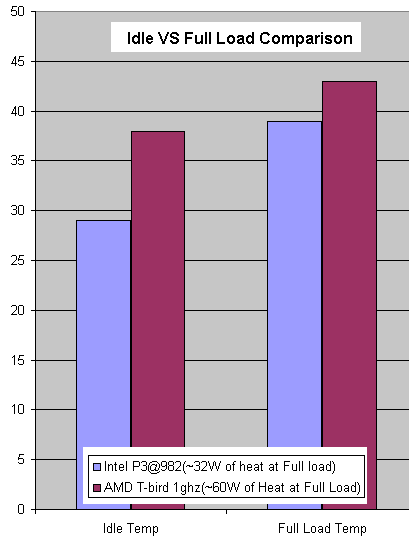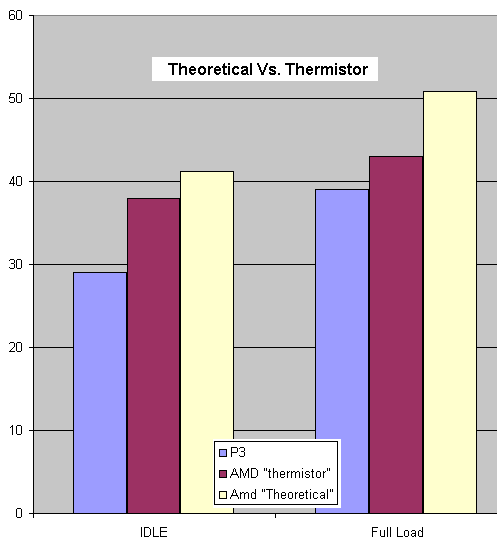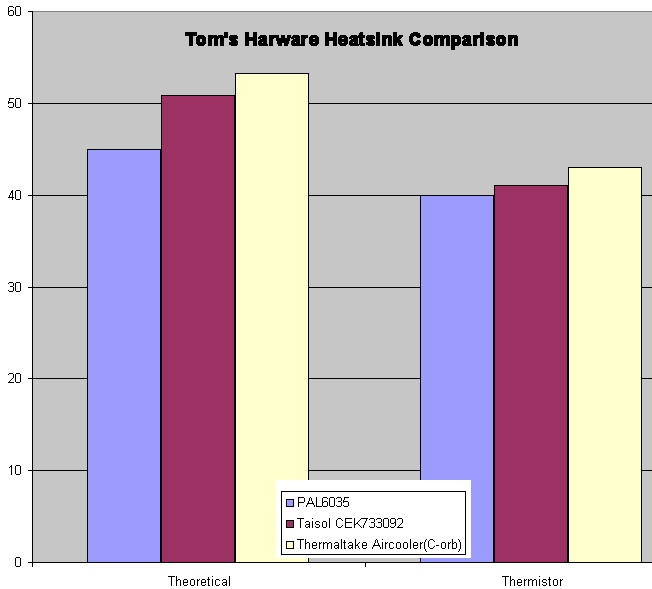|
|
|
Problem III: Compression of Temp results due to measuring a secondary heat pathway that is neither isolated from outside influences "air" or with a known resistance from measuring spot to cpu core.
One sign that temps are compressed with Socket A Mb's is the small difference in temperatures from Idle to Full Load in most cases. For example, on the kt7, on most occasions, the temperature change from idle to full load is only 5C. Comparing this idle drop versus a p3-internal diode reading (while itself is inaccurate, it does not compress readings and does show full temperature changes) in the following graph:

Ambient Temperature was 22C. The heatsink used for both tests was the taisol CEK733092(~.45C/W). Assuming accuracy for comparison purposes on a p3, the CPU Wattage at idle would be roughly 15W. Assuming accuracy for the socket A setup, one would get an idle W of 50W.
Not to mention, that in order for the t-bird to have a peak core temp of 42C, it would require an 13C ambient case temp.
Now, with the next graph, theoretical versus shown t-bird temps will be compared.
Since AMD chips do not offer the same HLT optimizations, I am guessing that
a 1ghz T-bird will idle at 45W, with Peak of 60W.
 A theoretical difference of 10C based on (c/w calculations,
with c=Temp of CPU-Ambient Case Temp) is read, by thermistor, as a 5C temp,
which is a compression of temp readings as compared to CPU core temps.
A theoretical difference of 10C based on (c/w calculations,
with c=Temp of CPU-Ambient Case Temp) is read, by thermistor, as a 5C temp,
which is a compression of temp readings as compared to CPU core temps.
To further examine the compression of temps, which leads to inaccurate comparisons, I will use two different Sets of Heatsink "comparison" results from both Anandtech and Toms Hardware.
The Taisol CEK733092 is measured at roughly .48C/W. The Orb series of heatsinks
is roughly .52C/W (as determined by Burning-Issues).
Based on Alpha specifications, the PAL6035 is roughly .38C/W, depending on the
fan used.
 As can be determined by the
thermistor readings on the Anandtech "comparison", the Alpha PAL6035
has a "read" temp of 45C, while the C-orb has a measured temp of 47C.
IF these readings were relative, then the theoretical numbers would measure
out to be exactly the same temperature difference as in the review.
As can be determined by the
thermistor readings on the Anandtech "comparison", the Alpha PAL6035
has a "read" temp of 45C, while the C-orb has a measured temp of 47C.
IF these readings were relative, then the theoretical numbers would measure
out to be exactly the same temperature difference as in the review.
Taking the .37 C/W for the Alpha (Alpha rates their heatsinks with the 21CFM Sanyo-Denki Fan), and .52C/W for the C-orb as measured by Burning-Issues, the theoretical temps for a CPU that creates about 55W of waste heat (as determined with the program Radiate)would result in actual core temperature difference is about 10C, not the 2C measured difference. Here is just one example of why the comparisons using socket A platforms are not "relative" and do not give a good indication of which heatsink is "really" better. Case temp was revealed as 29C in this Anandtech BBS Thread. In addition, even between the two PAL6035s(one with a YStech fan, the other with a Sanyo Denki Fan), the 1C measured temp difference is more like a 3C difference.
One important item to note is that the Theoretical Temperature would be absolute best Case Scenario. Any number of factors would alter this theoretical number upward.
Now looking at the Toms Hardware Review, You can see a "measured" temp difference between pal6035 versus Taisol CEK733092 as 1C.
 You can see the same general
problems as the Anandtech review, and some new ones as well. The taisol versus
alpha measured difference was 1C, but theoretically, that difference is more
like 10C. The Alpha versus C-orb was measured as 3c, but theoretically is roughly
8C. The new element is the unpredictability factor of the socket-thermistor
temp measurements. For one heatsink, it may read 5C too low, for another 10C
too low. All on the same MB. Yet one more reason not to use socket A motherboards
as comparison platforms.
You can see the same general
problems as the Anandtech review, and some new ones as well. The taisol versus
alpha measured difference was 1C, but theoretically, that difference is more
like 10C. The Alpha versus C-orb was measured as 3c, but theoretically is roughly
8C. The new element is the unpredictability factor of the socket-thermistor
temp measurements. For one heatsink, it may read 5C too low, for another 10C
too low. All on the same MB. Yet one more reason not to use socket A motherboards
as comparison platforms.
Unfortunately, the Anandtech review was "challenged" in their BBS. For various reason's on the bbs thread, the review was not amended in any way to show that the comparison was highly unpredictable and inaccurate.
So you get concerns about both accuracy of these numbers, but the readily viewable
"compression" of temp readings (mainly due to the fact that thermistor
measures a secondary heat pathway that is a fraction of actual CPU core temp
change) and an unpredictability factored into this "compression".
In addition, due to compression and unpredictability, the thermistor read results
are not Relative. Repeatable, definitely. Are they relative to actual core temp
changes, definitely not. These are the overriding factors that SHOULD keep websites
of any size from posing review's/comparisons with socket A heatsinks. It is
imperative to those larger websites, like Anandtech and TomsHardware , who have
far-reaching audiences, from posting comparisons that are both inaccurate, and
have results that are not even relative to cpu core temp changes.